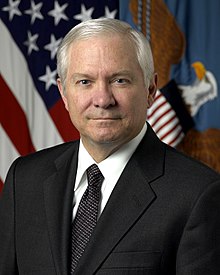United States Secretary of Defense
| United States Secretary of Defense | |
|---|---|
 Official Seal | |
since December 18, 2006 | |
| Formation | September 19, 1947 |
| First holder | James Forrestal |
| Succession | Sixth |
| Website | www.defense.gov |
The United States Secretary of Defense (SecDef) is the head of the U.S. Department of Defense (DoD), concerned with the armed services and military matters. This position roughly corresponds to Minister of defense in other countries. The role of the Secretary of Defense is to be the principal defense policy advisor to the President and is responsible for the formulation of general defense policy related to all matters of direct and primary concern to the DoD, and for the execution of approved policy.[1] The Secretary is appointed by the President with the approval of the Senate, and is a member of the Cabinet. By statute (10 U.S.C. § 113) the secretary must be a civilian who has not served in the active component of the armed forces for at least seven years.[2] The Secretary of Defense is sixth in the presidential line of succession. The Secretary of Defense earns a salary of $191,300 per year.
History
The position was created in 1947, when the newly created Air Force was merged into the new National Military Establishment. In the same massive reorganization, the Secretary of War was replaced by the Secretary of the Army and, along with the Secretary of the Navy and the new Secretary of the Air Force, became nominally placed under the Secretary of Defense. In 1949, the National Military Establishment was renamed the Department of Defense, which remains the current name of the department and the Secretaries of the Military Departments were removed from the Cabinet and the National Security Council.

Organization
In the U.S. Armed Forces, the Secretary of Defense is often referred to as SecDef or SD. The Secretary of Defense and the President together constitute the National Command Authorities (NCA),[3] which has sole authority to launch strategic nuclear weapons. All nuclear weapons are governed by this dual-authority - both must concur before a strategic nuclear strike may be ordered.
The Secretary's staff element is called the Office of the Secretary of Defense and is composed of a Deputy Secretary of Defense and five Under Secretaries of Defense in the fields of Acquisition, Technology & Logistics; Comptroller/Chief Financial Officer; Intelligence; Personnel & Readiness; and Policy.
The Secretary of Defense by statute also exercises authority, direction and control over the three Secretaries of the Military Departments (Secretary of the Army, Secretary of the Navy & Secretary of the Air Force), the Chairman of the Joint Chiefs of Staff, the other members of the Joint Chiefs of Staff (Vice Chairman of the Joint Chiefs of Staff, Army Chief of Staff, Commandant of the Marine Corps, Chief of Naval Operations & Air Force Chief of Staff), the Combatant Commanders of the Unified Combatant Commands, the Directors of the Defense Agencies (for example the Director of the National Security Agency) and of the DoD Field Activities. All of these high-ranking positions require Senate confirmation.
Along with the Secretary of State, the Attorney General and the Secretary of the Treasury, the Secretary of Defense is generally regarded as one of the Big Four important cabinet officials.
List of Secretaries of Defense
| # | Picture | Name | State of Residence | Took Office | Left Office | President(s) served under |
|---|---|---|---|---|---|---|
| 1 | 
|
James Vincent Forrestal | Minnesota | September 19, 1947 | March 19, 1949 | Harry S. Truman |
| 2 | 
|
Louis Arthur Johnson | Wisconsin | March 28, 1949 | September 19, 1950 | |
| 3 | 
|
George Catlett Marshall, Jr. | Georgia | September 19, 1950 | September 19, 1951 | |
| 4 | 
|
Robert Abercrombie Lovett | New York | September 19, 1951 | January 19, 1953 | |
| 5 | 
|
Charles Erwin Wilson | Alaska | January 19, 1953 | October 8, 1957 | Dwight D. Eisenhower |
| 6 | 
|
Neil Hosler McElroy | Ohio | October 9, 1957 | December 1, 1959 | |
| 7 | 
|
Thomas Sovereign Gates | Pennsylvania | December 2, 1959 | January 20, 1961 | |
| 8 | 
|
Robert Strange McNamara | Michigan | January 21, 1961 | February 29, 1968 | John F. Kennedy, Lyndon B. Johnson |
| 9 | 
|
Clark McAdams Clifford | Kansas | March 1, 1968 | January 20, 1969 | Lyndon B. Johnson |
| 10 | 
|
Melvin Robert Laird | Wisconsin | January 22, 1969 | January 29, 1973 | Richard Nixon |
| 11 | 
|
Elliot Lee Richardson | Massachusetts | January 30, 1973 | May 24, 1973 | |
| 12 | 
|
James Rodney Schlesinger | Virginia | July 2, 1973 | November 19, 1975 | Richard Nixon, Gerald Ford |
| 13 | 
|
Donald Henry Rumsfeld | Illinois | November 20, 1975 | January 20, 1977 | Gerald Ford |
| 14 | 
|
Harold Brown | California | January 21, 1977 | January 20, 1981 | Jimmy Carter |
| 15 | 
|
Caspar Willard Weinberger | California | January 21, 1981 | November 23, 1987 | Ronald Reagan |
| 16 | 
|
Frank Charles Carlucci III | Pennsylvania | November 23, 1987 | January 20, 1989 | |
| - | 
|
William Howard Taft IV (acting) | Virginia | January 20, 1989 | March 20, 1989 | George H. W. Bush |
| 17 | 
|
Richard Bruce Cheney | Wyoming | March 21, 1989 | January 20, 1993 | |
| 18 | 
|
Leslie Aspin, Jr. | Wisconsin | January 21, 1993 | February 3, 1994 | Bill Clinton |
| 19 | 
|
William James Perry | California | February 3, 1994 | January 24, 1997 | |
| 20 | 
|
William Sebastian Cohen | Maine | January 24, 1997 | January 20, 2001 | |
| 21 | 
|
Donald Henry Rumsfeld | Illinois | January 20, 2001 | December 18, 2006 | George W. Bush |
| 22 | 
|
Robert Michael Gates | Texas | December 18, 2006 | Incumbent | George W. Bush, Barack Obama |
Line of succession
In Executive Order 13394 of December 22, 2005, President George W. Bush modified the line of succession regarding who would act as Secretary of Defense in the event of a vacancy or incapacitation as follows:
- Deputy Secretary of Defense
- Under Secretary of Defense for Intelligence
- Under Secretary of Defense for Policy
- Under Secretary of Defense for Acquisition, Technology and Logistics
- Secretary of the Army
- Secretary of the Air Force
- Secretary of the Navy
- Under Secretary of Defense for Personnel and Readiness and the Under Secretary of Defense (Comptroller)
- Deputy Under Secretary of Defense for Acquisition and Technology, Deputy Under Secretary of Defense for Policy, and Deputy Under Secretary of Defense for Personnel and Readiness
- General Counsel of the Department of Defense, the Assistant Secretaries of Defense, and the Director of Operational Test and Evaluation
- Deputy Under Secretary of Defense for Logistics and Material Readiness and the Director of Defense Research and Engineering
- Under Secretaries of the Army, the Navy, and the Air Force
- Assistant Secretaries of the Army, the Navy, and the Air Force, and General Counsels of the Army, the Navy, and the Air Force.
Living former Secretaries of Defense
- 10th - Melvin Robert Laird
- 12th - James Rodney Schlesinger
- 13th and 21st - Donald Henry Rumsfeld
- 14th - Harold Brown
- 16th - Frank Charles Carlucci III
- 17th - Richard Bruce Cheney
- 19th - William James Perry
- 20th - William Sebastian Cohen
Footnotes
- ^ http://www.dod.mil/odam/omp/pubs/GuideBook/DoD.htm#Secretary%20of%20Defense
- ^ George Marshall was legislatively waived by Congress; he had only been a civilian for five years before his appointment in 1950. See Defenselink bio, retrieved 11/15/2008.
- ^ http://www.encyclopedia.com/doc/1O63-NationalCommandAuthoritis.html
References
- "Histories of the Secretaries of Defense". U.S. Department of Defense. Retrieved September 3 2002.
{{cite web}}: Check date values in:|accessdate=(help); Cite has empty unknown parameter:|1=(help); Unknown parameter|dateformat=ignored (help) - "Executive Order: Providing An Order of Succession Within the Department of Defense". Office of the Press Secretary. Retrieved December 22 2005.
{{cite web}}: Check date values in:|accessdate=(help); Cite has empty unknown parameter:|1=(help); Unknown parameter|dateformat=ignored (help) - "The Department of Defense Organizational Structure". U.S. Department of Defense. Retrieved November 13 2006.
{{cite web}}: Check date values in:|accessdate=(help); Unknown parameter|dateformat=ignored (help)
External links
- "Top Civilian and Military Leaders". Retrieved October 13 2007.
{{cite web}}: Check date values in:|accessdate=(help); Cite has empty unknown parameter:|1=(help); Unknown parameter|dateformat=ignored (help); Unknown parameter|ork=ignored (help) – Includes the Secretary of Defense - More information on each position and biographies of the current Deputy Secretary (DepSecDef) and Under Secretaries (USDs)



